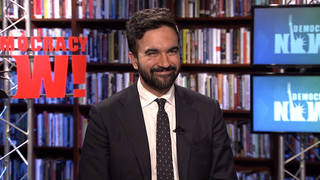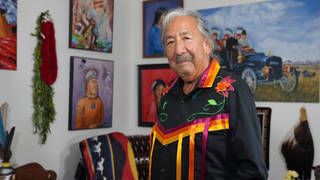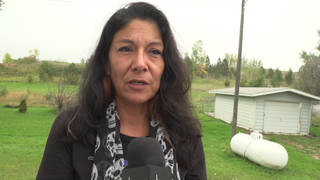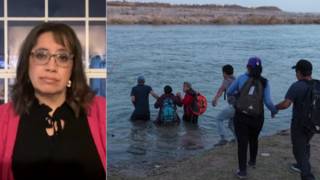
Guests
- Sonia NazarioPulitzer Prize-winning journalist and board member of Kids in Need of Defense. She is author of Enrique’s Journey: The Story of a Boy’s Dangerous Odyssey to Reunite with His Mother.
With 10 people dead in San Antonio, Texas, following a human smuggling attempt, we look at how the U.S. border crackdown is contributing to human trafficking and increases in death among immigrants fleeing violence in Central America. We speak with Sonia Nazario, Pulitzer Prize-winning journalist and board member of Kids in Need of Defense.
Transcript
JUAN GONZÁLEZ: I’d like to bring Sonia Nazario into the conversation, Pulitzer Prize-winning journalist and author of Enrique’s Journey: The Story of a Boy’s Dangerous Odyssey to Reunite with His Mother. Sonia, you hear about this tragedy. Your reaction initially? And also, you’ve obviously pointed out in many articles that the huge flow that’s coming into the United States now is largely from Central America through Mexico. And could you talk about the impact of these crackdowns on and the results of more migrants dying along the border?
SONIA NAZARIO: Well, obviously, I think what this truck driver did was disgusting, and he should be punished to the full extent of the law. But I think this is a very predictable outcome of this crackdown on the border. You’re seeing more and more people—you know, mostly folks coming here, as you said, now coming here unlawfully, are Central Americans, not Mexican. And they’re mostly fleeing some of the most violent countries on Earth: Honduras, El Salvador, Guatemala. And in recent years, I focus on the most vulnerable of those who are coming here from Central America: immigrant children, 5-, 10-, 12-year-old kids who are trying to get into the United States and flee that violence. They’ve been recruited by gangs or by narco cartels, and they feel that their lives are in danger, and so they’re trying to reach the United States and reach, oftentimes, a parent, reach safety here in the United States.
In the last couple of years, these kids were turning themselves in to the Border Patrol agents, and they were trying to find the Border Patrol agents when they reached the border. And what we’re seeing as a result of this crackdown on the border is that if nine in 10 turned themselves in in January, today perhaps only half of them are turning themselves in. And they’re trying to circumvent, as Mr. Canales said, these checkpoints. They’re trying to walk into the border. And that’s where we see these deaths, when these children are trying to circumvent these checkpoints. They get lost. They get disoriented. They’re walking in 120-degree heat without enough water. You can’t carry enough water to be able to survive in these kinds of desert-like conditions on the border. So this is a very predictable outcome.
In 2015, as a response to so many children arriving at the border in 2014—there was a surge of these unaccompanied immigrant children—the U.S. funded a crackdown. They paid tens of millions of dollars to Mexico to fund this brutal crackdown aimed at preventing these children from arriving at our border. And what we saw is that children who were traveling on buses with smugglers were then being put in these tractor-trailers in Mexico.
And I heard a story yesterday, a 15-year-old girl, two days locked into one of these trailers with 200 people in 110-, 120-degree heat. She had a 13-year-old boy who died next to her. And she was in that trailer for two days with that body. They’re given buckets to go to the bathroom in. And as the trailers move around, these buckets tip over, and you’re up to your ankles in excrement. These are horrific things that are happening. And we’re seeing more people being transported now in trailers. In Laredo in the last month, they found four of these trailers, full of immigrants.
And so, in an effort to try to circumvent the smugglers, the cartels are resorting to more and more desperate measures. This doesn’t work. Ninety-seven percent of people who try repeatedly to get into the United States, surveys show, are able to get into the United States. So, not only is it inhumane, it doesn’t work. And I believe that we’re seeing in Congress a growing movement among some representatives, some senators, to recognize that the only thing that really will work is to address the root causes of what’s pushing people out of these three very violent countries. And—
JUAN GONZÁLEZ: And, Sonia, if I can interrupt?
SONIA NAZARIO: Yeah.
JUAN GONZÁLEZ: You have written about programs that have worked in reducing the flow of migrants, when the emphasis was shifted to improving the conditions in some of these countries, like Honduras especially. You wrote about San Pedro Sula. Could you talk about that, as well?
SONIA NAZARIO: Sure. Well, instead of these crackdowns, which result in increases in deaths on the border—and, you know, we see about 300 people die trying to walk into the United States every year—two years ago, the U.S. started funding violence prevention programs, pilots, in some of the most violent neighborhoods in Honduras. I went to the most violent neighborhood in—called Rivera Hernández in the town of San Pedro Sula in Honduras. For four years running, this town had the highest homicide rate in the world. And in this neighborhood, two, three years ago, bodies littered the streets in the morning. The gangs operated so brazenly, the six gangs, that one day they were playing soccer with the decapitated head of someone that they had just executed.
So, but the U.S. went in, and they organized leaders in this neighborhood, tried to reweave the social fabric. They founded outreach centers where kids could go and get mentors and vocational training, help getting jobs. We took a program that worked in Los Angeles, where I live, the GRYD program. You identify kids who have some of the nine risk factors of going into gangs. If they have half of those risk factors, put them into a year of family counseling, and that means that they’re 77 percent less likely to engage in crime and use drugs or alcohol.
And then, the final thing we did was we funded a nonprofit that went into these neighborhoods. In Honduras, 96 percent of all homicides result in no conviction. You can murder someone in broad daylight, and you can get away with it, because witnesses won’t step forward because they know tomorrow they’ll be dead. So we funded a nonprofit that went into this neighborhood, investigated all homicides, and they convinced witnesses to testify with a black burqa over them—so, like they do with Mafia trials in Italy. And I witnessed this. And now they’re getting convictions on more than half of the homicides. This resulted, in two years, in a 62 percent drop in homicides in this neighborhood.
And what you’ve seen in Honduras with these few pilots, if, two years ago, 18,000 Honduran children were arriving unaccompanied at our border and being apprehended, that number, in two years, was nearly cut in half. And El Salvador, Guatemala, that have not implemented these programs to this degree, are seeing the number of children arriving at our border increasing. In Honduras, this costs $100 million a year to do. And I know many Americans would say, “Well, I don’t want to spend one red cent in foreign lands.” But you’re spending billions of dollars processing these immigrants, dealing with them, paying for greater Border Patrol, putting these kids in school while their immigration cases proceed. It costs billions to deal with these folks once they’re here. It’s much cheaper. It’s humane. And it actually works, unlike the wall.
AMY GOODMAN: Sonia Nazario, The New Yorker magazine recently posted quotes by an unnamed ICE agent who spoke out against Trump’s deportation plans. The agent said, quote, “The whole idea is targeting kids. I know that technically they meet the legal definition of being adults. Fine. But if they were my kids traveling in a foreign country, I wouldn’t be O.K. with this. We’re not doing what we tell people we do. If you look next month, or at the end of this month, at the people in custody, it’s people who’ve been here for years. They’re supposed to be in high school,” the person said. And Reuters is reporting that ICE is planning to launch a series of nationwide raids this week targeting undocumented teenagers for deportation. Your response, as we wrap up?
SONIA NAZARIO: Well, I think that, previously, we categorized—we prioritized going after criminals. Now we’re going after that 5-year-old who arrives or that 10-year-old who arrives to this country alone, seeking safety from us. They are refugees. And I believe that we should treat refugees in a compassionate way. If we can’t have compassion towards a child who is running from danger, then I think we have lost our moral compass. With these children, they’re now afraid to tell Border Patrol agents or people who are trying to help them after they’ve been apprehended—they’re afraid to tell them the names of their parents, because DHS just released information to officials in D.C. that they have picked up 270 sponsors of these children. Sponsors are usually parents that these children are released to while their immigration cases are proceeding. So these children are now terrified to tell anyone if they even have a relative in this country, because they fear that then that relative will be picked up and be deported. Instead of targeting people who are criminals, who are rapists, who are murderers, we’re going after children. And we’re separating them violently from the parents that they could be released to while their immigration cases are proceeding. I think that that’s very mixed-up priorities in terms of our government. And I think many Americans are compassionate, especially towards refugees, people who are fleeing for their lives.
AMY GOODMAN: Well, we want to thank you both for being with us, Sonia Nazario, Pulitzer Prize-winning journalist, author of Enrique’s Journey, and Eddie Canales, joining us from Texas, the South Texas Human Rights Center. Of course, we’ll continue this story.
When we come back, it’s been 50 years since the Detroit and Newark uprisings. We’ll talk about what happened then and what it means for today. Stay with us.












Media Options